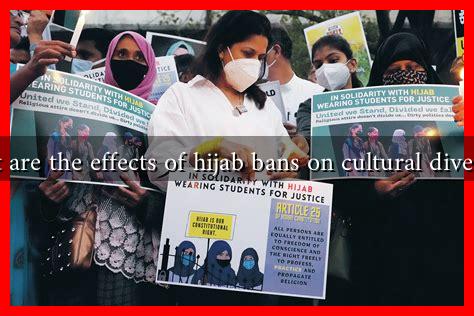-
Table of Contents
What are the Effects of Hijab Bans on Cultural Diversity?
The hijab, a traditional headscarf worn by many Muslim women, has become a focal point of cultural and political debate in various parts of the world. In recent years, several countries have implemented bans on the hijab, citing reasons ranging from secularism to security. However, these bans have profound implications for cultural diversity, affecting not only the individuals who wear the hijab but also the broader societal fabric. This article explores the effects of hijab bans on cultural diversity, examining the social, psychological, and economic dimensions of this issue.
The Social Impact of Hijab Bans
One of the most immediate effects of hijab bans is the marginalization of Muslim women in society. When a government enforces a ban on the hijab, it sends a message that the cultural practices of a significant portion of the population are not valued. This can lead to:
- Increased Stigmatization: Women who choose to wear the hijab may face discrimination and social ostracism, leading to feelings of isolation.
- Loss of Identity: The hijab is often a symbol of faith and identity for many Muslim women. Bans can strip them of their cultural expression.
- Community Division: Such bans can create rifts between different cultural and religious groups, fostering an environment of intolerance.
For instance, in France, where the hijab has been banned in public schools since 2004, many Muslim girls have reported feeling alienated and unwelcome in educational settings. This has led to a decline in their academic performance and participation in school activities.
Psychological Effects on Individuals
The psychological ramifications of hijab bans are significant. Women who are forced to remove their hijabs may experience:
- Identity Crisis: The hijab is often intertwined with personal and religious identity, and its removal can lead to confusion and distress.
- Increased Anxiety and Depression: The pressure to conform to societal norms can lead to mental health issues, particularly among young women.
- Fear of Repercussions: Women may fear backlash or violence for wearing the hijab in public, leading to increased anxiety.
A study conducted by the University of California found that Muslim women in countries with hijab bans reported higher levels of anxiety and depression compared to those in more accepting environments. This highlights the need for supportive policies that promote mental well-being.
Economic Consequences
Hijab bans can also have economic implications, particularly in terms of employment and entrepreneurship. Women who wear the hijab may face barriers in the job market, leading to:
- Limited Job Opportunities: Employers may discriminate against hijab-wearing women, reducing their chances of employment.
- Underemployment: Many hijab-wearing women may be forced to accept lower-paying jobs due to discrimination.
- Impact on Entrepreneurship: Women may be discouraged from starting businesses in environments where their cultural practices are not accepted.
For example, a report by the European Network Against Racism (ENAR) indicated that Muslim women in Europe face a 20% higher unemployment rate than their non-Muslim counterparts, largely due to discrimination related to their attire.
Case Studies: Global Perspectives
Several countries have implemented hijab bans, each with unique cultural contexts and consequences:
- France: The 2004 ban on religious symbols in schools has led to significant social tensions and protests, highlighting the clash between secularism and religious expression.
- Turkey: The lifting of the hijab ban in 2013 marked a shift towards greater acceptance of cultural diversity, allowing women to express their identities freely.
- India: Recent controversies surrounding hijab bans in educational institutions have sparked nationwide debates about religious freedom and cultural rights.
Conclusion
The effects of hijab bans on cultural diversity are multifaceted, impacting social cohesion, individual psychology, and economic opportunities. These bans not only marginalize Muslim women but also undermine the principles of inclusivity and acceptance that are vital for a diverse society. As countries navigate the complexities of cultural expression and secularism, it is essential to foster dialogue and understanding rather than division. Promoting policies that respect cultural diversity can lead to a more harmonious society where all individuals feel valued and included.
For further reading on the implications of cultural policies, you can explore resources from organizations like the Human Rights Watch and the Amnesty International.

